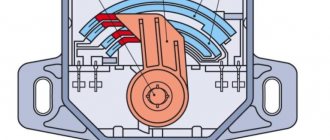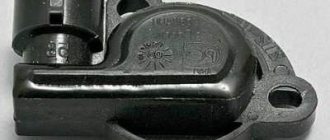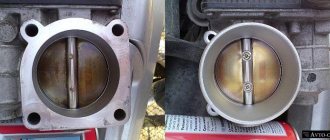12
The throttle valve (DZ) is a mechanical regulator. It is located in the passage between the air valve and the manifold. It is needed to regulate air flows that must mix with fuel. It is an important element of the intake structure of the fuel system, leading directly to the engine.
Throttle valve: signs and symptoms of a malfunction, causes of problems with the sensor, solution to the problem - all this can be found in the article.
How to understand that the throttle valve is faulty
There are several signs of a bad throttle sensor:
- When starting the engine, poor performance is observed;
- The consumption of fuel resources increases;
- The power is not stable, there are cases of its loss;
- The running engine suddenly turns off. When you turn it on again, it works for a certain time, then stalls again;
- At a speed of 120 km/h, traction may be lost;
- The emergency light starts flashing, indicating an error;
- The car is slow to accelerate and does not climb well;
- You can hear popping noises and the smell of gasoline from the exhaust pipe;
- Turnover becomes unstable;
If more symptoms of a malfunction of the throttle position sensor were noticed, this indicates that you need to find the cause and eliminate it. TPS signs of malfunction may also indicate other malfunctions of vehicle components.
Checking the performance of the TPS
If during operation of the vehicle at least one of the signs of malfunction of the throttle position sensor was detected, its functionality must be checked. To do this, the car owner does not require any special knowledge. It is enough to have a multimeter and know a clear sequence of actions.
The main thing to remember is that the Check Engine is a light that is installed specifically to signal the driver about a faulty engine. If it lights up, then you need to immediately contact a service station or fix the problem yourself.
If there are no problems, the light will light up when the engine starts and go out instantly when the diagnosis is complete. If the Check Engine light remains on, there is a problem with the system. In this case, you cannot do without an experienced specialist.
Regarding the identification of throttle valve malfunctions, the symptoms of which were identified during the operation of the car, there is a certain algorithm of actions:
- The first thing you need to do is turn off the ignition, inspect the instrument panel, notice whether the Check Engine indicator light is on or not, which signals the presence of problems. If the indicator does not light up, you need to climb under the hood and check the TPS.
- Next, you will need a multimeter - a special device to check the operation of the throttle sensor.
- It is necessary to determine the presence of a “minus”. In order not to discard each wire separately, it is worth piercing the necessary wires and measuring them.
- The search for “mass” is carried out in the same way. There is no need to turn on the ignition during the mechanism check period.
The purpose of performing preliminary actions is to check the availability of power to the PD sensor. The voltage depends on the make of the car. For example, for some machines it may be only 5 V, while for other models it may be 12 V.
Algorithm of actions for identifying TPS faults, the symptoms of which were identified while the vehicle was moving:
- you need to turn on the ignition and pierce the wires of the required chain one by one using a multimeter. The device display should show a voltage reading of 0.7 V;
- the throttle valve opens manually: the voltage value must be greater than 4 V;
- The ignition is turned off, one connector is discarded. In the area between the slider terminal and the wire (which remains), a multimeter probe is connected;
- Now you need to manually scroll the sector and observe the readings of the measuring device. If there is a smooth increase in values without sudden jumps, it means that the PD sensor is working normally. In the opposite situation, we can talk about damage (scuffing) of the resistor track.
These indicators affect the proper functioning of the electronic control unit (ECU), which controls the main operating processes of a car engine and the supply of fuel mixture to the injectors. If inaccurate numbers are supplied to the ECU, then the control unit will make incorrect decisions.
For example, the throttle valve is fully open, but the electronic device shows that it is closed. If such symptoms are present, this is an obvious malfunction of the throttle sensor and must be replaced.
Damper contaminated
The design of the throttle valve is directly connected to the ventilation system through which gases escape. This may lead to contamination. Dirt, dust, oil, and resinous formations most often settle on the walls. Subsequently, noise, knocking, and extraneous sounds may be observed. The operation of this equipment becomes poor. The electronic system indicates an error on the dashboard.
If you constantly clean this unit with special products designed for treating the carburetor system, then you can avoid TPS malfunction.
FAQ
Can I clean the throttle body myself?
Of course, you can do this, but for flushing you need to understand that the problem lies precisely in its contamination. These actions will not always help.
How can I wash the throttle body in the engine?
You can wash the throttle assembly with a regular carburetor cleaner. More expensive products are worth buying only if cleaning requires removal.
How to change the sensor on the throttle valve?
In most cars with a simple engine, to replace the sensor, you just need to disconnect and unscrew the old one and screw and connect the new sensor.
How much does a throttle valve cost?
The cost will be quite high, since the knot is complex. It is worth buying only a new original unit, otherwise there will be no point in such a replacement.
Throttle sensor problems
The remote control has a position sensor. This device is responsible for the reliability of data on the operation of this unit and its transmission to the ECU center. He, in turn, processes the symptoms of TPD. Thanks to it, there is an uninterrupted supply of air and its correct ratio with fuel resources, and there is an instant response to starting the engine.
If signs of a malfunction in the TPS become obvious due to false information or its complete absence, then the car’s electrical system processes the indicators and puts the entire system into standby mode. A signal appears on the corresponding light bulb. Signs of a malfunctioning throttle position sensor may indicate major problems with the transmission system.
Types of TPS faults
Problems with the operation of the throttle sensor are associated with its design design, and are generally characteristic of most variable resistors. Car enthusiasts identify three main problems:
- Wear of the moving contact or film resistance.
- Backlash of fastenings.
- Oxidation of active contacts.
During the operation of the moving contact and interaction with the film resistance, constant friction arises, which, with prolonged exposure, wears out both the resistive layer and the surface of the active contact itself. Practice shows that the degree of wear directly depends on driving style and manifests itself extremely unevenly. Because of this, only in some places places are formed where the active contact does not reach the resistive layer, causing the voltage to disappear at the output of the throttle position sensor.
In this case, in older fuel-injected vehicles, fuel delivery is reduced and the risk of engine detonation increases. In modern fuel-injected internal combustion engines, the system blocks the operation of the power unit and activates the “check engine” indicator.
Oxidation of working contacts occurs exclusively under conditions of high humidity under the hood. As a result, the resistance may increase and the electrical contact may be completely broken.
System depressurization
If depressurization occurs in the intake tract system, then instability in engine operation occurs. Air leaks occur in the following parts of the car:
- In sealed areas of the nozzle;
- On exhaust systems for gasoline vapors;
- On the walls of the throttle frame;
- On idle jets;
- On the vacuum brake booster pipes;
- On the cleaning pipes.
Due to improper air removal, improper mixing of fuel masses occurs. Emergency symptoms are detected during the operation of the intake tract. The air leaving the system does not pass through the filtration system. It contains many harmful particles of dirt, metal, and plastic, which enter the engine and threaten to lead to poor performance of the latter.
Why do chokes fail?
Breakdowns are possible if you use low-quality fuel and do not change the air and fuel filters on time. There will also be increased wear if the air supply system is leaky. Various small particles will get into the damper body, which sooner or later will lead to a serious problem.
Failure of sensors is due to the following features:
- Incorrect power supply to the sensors is the most common problem in older cars;
- physical damage to the sensors - do not hit them with a hammer in the hope that they will work better;
- natural wear and tear - sensors are designed for a certain service life, sooner or later they will fail;
- factory defects or low-quality sensors are also a common problem in Russia and the CIS countries;
- incorrect installation - an installation problem often leads to rapid failure of the IAC and TPS;
- Incorrect first start - after installing new idle air controls, some cars will require sensor training.
You should always consult your vehicle's owner's manual to ensure all repairs and service procedures are carried out correctly. Otherwise, you will encounter problems with the electrical part of the car quite often.
Damper adaptation problem
Adaptation may spontaneously reset. This will result in:
- The battery will turn off and on.
- Unstable operation in the electronic center of the car. It will freeze, show incorrect information, and indicate many errors.
- The engine will turn off.
The reasons that lead to this may be the following actions performed previously:
- When the battery pack was removed and installed back;
- The electronic system was being re-flashed;
- The throttle valve was removed for repair or cleaning;
- The accelerator pedal was dismantled;
- Poor condition of the power cord;
- Excess moisture getting into the chip.
If the electronic system is worn out, shows incorrect data, or turns off, the problem may lie in the potentiometer. It is in the middle of the throttle. Its design contains graphite ribbons that require replacement.
How to check TPS Lada Kalina
You can diagnose the Lada Kalina TPS without dismantling this element. For this purpose, you can use a multimeter or any DC voltmeter designed for low voltage.
Checking the functionality of the element is carried out in the following sequence:
- Disconnect the negative terminal of the battery.
- Disconnect the wires from the sensor. The plug can be easily removed by slightly pressing the lock upward and pulling the wires to the side.
- Connect the “+” of the multimeter to the contact of the sensor through which power is supplied. The conductor should be connected using a thin copper wire.
- Install the plug onto the sensor.
- Connect the battery.
- Turn on the ignition.
- Connect the “–” of the multimeter to the “ground” of the car.
If power is supplied to the TPS, the display of the electronic meter will show a voltage in the range from 4.5 to 5.0 Volts. If current is supplied to the sensor, but the engine is still unstable, then a more detailed check should be carried out. For a more accurate diagnosis, you will need an assistant. To carry out the work of measuring voltage while moving the throttle valve, you must:
- Turn off the ignition and disconnect the negative terminal of the battery.
- Connect the “+” of the tester to the TPS terminal, which goes to the electronic control unit, and “–” to the vehicle ground.
- Connect the battery and turn on the ignition.
- Ask an assistant to gently press the gas pedal.
When the damper opens smoothly without jerking, the voltmeter readings should also change. When the positions of this element correspond to the maximum flow of gasoline into the engine, the voltage should be about 5 Volts. With the damper completely closed, the main terminal of the sensor should be in the range from 0 to 0.5 Volts.
If, during diagnostic work, no deviations in the change in output voltage were detected or the potential difference did not increase smoothly when the damper was slowly opened, then this part must be replaced.
Throttle Actuator
There are 2 types of these devices. The first is mechanical. It can be found on cars produced before 2000. The design of this device contains a steel cable, which over time can deform, stretch and even break. The cable connects these two nodes: the accelerator pedal and the handle on the rotation axis. The pressure exerted on it damages its structure and leads to loss of integrity.
The second type is electronic. It can be found on all modern cars. The position can be adjusted using the electrical control center. In accordance with the indicators about the state of the system, the last node, analyzing it, sends commands to the throttle unit. If data is received that reads signs of a malfunctioning throttle sensor, an alarm is generated. The electrical unit, in turn, registers this. Enables emergency mode. The warning light comes on.
What are the symptoms of a malfunctioning throttle position sensor:
- The vehicle does not respond to the signal sent to the main engine unit by pressing the accelerator pedal.
- The speed has decreased, the car picks up speed poorly.
- The dynamics deteriorate, the car takes turns poorly.
- During a cold start, insufficient speed may be observed, and the engine may turn off on its own.
- Alarms are issued regarding errors in the system.
There are times when the electric throttle unit starts to malfunction. Then, having detected this problem, the car switches on the emergency lights.
Types of remote control position sensors
Today, the automotive industry presents two types of sensors:
- Contact potentiometer. Used by all vehicle manufacturers. The design has a slider and resistive tracks. It is rigidly mounted on the throttle pipe and connected to the axle. It works based on voltage dynamics, which contributes to the correction of the fuel supply ECU. When pressure is applied to the accelerator, the throttle opens, which turns the axis and moves the slider, changing the length of the resistive tracks of the electrical circuit.
- Contactless. Produced as an alternative potentiometer. It works based on dynamic changes in the influence of the magnetic field. The slider does not contact the working part because it has a permanent magnet. The electronic element reacts to changes. It is believed that such sensors are more durable and less likely to break. However, it is worth considering that they cost an order of magnitude higher.
It is believed that magnetoresistive sensors are more durable and less likely to break. However, it is worth considering that they cost an order of magnitude higher.
Features of throttle valve repair
When these signs and symptoms of a TPS malfunction are recorded, then repair work should be carried out. Their process depends on the problem. They may come as a set or require replacement of one unsuitable part. What is most often done:
- If the throttle sensors are acting up or faulty, then they should be replaced. They are not subject to repair work.
- It is imperative to clean the cold start regulator and the throttle valve from dirt.
- Replacing gaskets, corrugated connecting tubes, restoring the tightness of the throttle valve.
- Replacing an old, out-of-service device with a new one.
Types of TPS on Priora
Why do Priora car owners need to read this section, which describes the types of TPS sensors. Indeed, if you suspect a malfunction of this sensor, it is more important to first check it, and if the result is positive, replace it. All this is correct, but you need to know the types of TPS in order to choose the optimal device option for your car when replacing, which will not only last a long time, but also ensure more efficient and high-performance operation.
That is why there are two types of throttle position sensors. They have corresponding names, and differ in design, as well as principle of operation. In fact, you will learn about them further:
- Film-resistor (or resistive) TPS - it is also called a contact or mechanical device, which has a simple design and functions by changing the resistance. It consists of resistive tracks and a movable slider, which is connected directly to the throttle valve axis. Moving the slider along the track causes a change in resistance, which causes a voltage drop in the circuit. It is based on the change in voltage that the ECU understands what position the damper is in. In the design of Priora cars, sensors of the film-resistive type are most often installed from the factory, which are characterized by their low cost. Such a sensor has three contacts, one of which is a stabilized voltage of 5V, the second is ground, and the third is a signal contact, from which readings are taken and sent to the ECU.
- A non-contact sensor or magnetoresistive sensor is a potentiometric device that consists of a permanent magnet that changes its position depending on the angle of rotation of the damper. Such sensors are more advanced and accurate, and are also characterized by a longer service life, which is due to the absence of contact elements. Moreover, their price is higher than the cost of resistive devices (about 2 times).
Having an idea of what types of TPS there are, you should consider the features of their functioning, which will be useful when carrying out test manipulations.
Cleaning the throttle valve
This part of the car must be cleaned properly. Detailed instructions:
- You should remove the throttle valve. To do this, you should first remove the air duct connecting the throttle to the air filter. This can be done with a special key.
- The next step is to remove the damper itself. Depending on the design features of the motor, this manipulation is performed with some differences. But the main steps are as follows: remove the fastening bolts and disassemble the superimposed connectors.
- Cleaning is carried out with special products that have excellent cleaning properties and remove even the slightest deposit of oily contaminants. Carburetor cleaner is in demand. It can be found at any automotive store. Its cost is affordable.
- The product is sprayed onto the surface of the damper and the dirt is removed using a dry piece of cloth. No effort required. By lightly swiping with a cloth you can quickly clean the throttle from above and inside.
- If there is a protection grille, then this should also be cleaned.
- Install the remote control, connect all previously removed parts, and screw on the air duct.
- Check the system operation.
Location and principle of operation of the meter
The sensor is installed on the throttle valve block and is mechanically connected to its axis. Thanks to this, the device is able to solve 3 problems:
- inform the controller at what angle the throttle is currently open;
- signal that the air supply is completely closed (the driver has released the accelerator pedal);
- monitor the speed at which the damper opens.
Based on this information, the electronic powertrain control unit (ECU) makes a decision to increase or decrease the fuel supply and fuel injection for intense acceleration when the gas pedal is sharply pressed.
The operating algorithm of the resistive sensor is as follows:
- At idle, the damper is closed and air flows into the engine through a separate channel. The voltage at the output of the device does not exceed 0.5 volts; the controller supplies fuel to maintain engine idle speed.
- When the driver presses the gas pedal, the sensor slider moves along the resistive film. The resistance of the electrical circuit into which the device is connected in series decreases.
- The ECU “sees” the increase in voltage in the meter circuit, makes a calculation, prepares the air-fuel mixture in the required quantity and supplies it to the cylinders. The maximum voltage at wide open throttle is about 4.5 V.
- When the driver sharply presses the accelerator pedal, the controller notes a similar voltage surge and delivers a portion of the enriched mixture for dynamic acceleration.
Note. The operating voltage values are indicated for a common Russian car - VAZ 2110.
The non-contact throttle position sensor functions identically. The difference lies in the method of influencing the electrical circuit. A resistive device changes resistance using a slider moving across the film, while a non-contact device changes resistance due to the magnetic-resistive effect. Thanks to this principle of operation, the TPS lasts much longer and does not create problems for the owner of the car.
Preventive measures
The DZ has a long service life and rarely breaks down. But mechanical damage to the housing itself may occur, or repair work must be carried out in the engine system. Then it or its components can be replaced. The sensor is always in the risk zone. It cannot be repaired and often needs to be replaced with a new one.
To prevent damage to this unit, it must be cleaned regularly. According to the manufacturer's recommendation, this should be done when changing the oil or after 20,000 km. mileage If these recommended preventive measures are taken, then the throttle valve and its sensor can serve the car owner for more than one year and subsequently will not need to be replaced.
Similar news:
- Diagnostics and troubleshooting of the mass sensor...
- Causes and solutions to the problem of squealing car brakes
- Causes of strong engine vibrations at idle
- Selection of spark plugs by car make, by VIN code
- Fuel consumption of Chrysler Sebring
- Fuel rail pressure tester
- Design and principle of operation of an automatic transmission
- Characteristics of the rotary engine, its pros and cons
Recommendations for choosing TPS
Quite often, car manufacturers install a cheap film-resistive throttle sensor. Such a mechanism will not work for a long time, and very soon symptoms of its malfunction will begin to appear.
Therefore, when replacing, it is recommended to use a non-contact sensor, which is more expensive, but is more reliable in operation and has a long service life. Its working principle is based on the magnetoresistive effect.
Sources
- https://autoleek.ru/sistemy-dvigatelja/vpusknaya-sistema/drosselnaya-zaslonka.html
- https://VazNeTaz.ru/drosselnaya-zaslonka
- https://seite1.ru/zapchasti/drosselnaya-zaslonka-ustrojstvonaznacheniechistkaremont/.html
- https://avtozam.com/elektronika/sensor/kak-proverit-dpdz/
- https://tolkavto.ru/raznoe/drosselnaya-zaslonka-eto-chto-takoe.html
- https://seite1.ru/zapchasti/datchik-drosselnoj-zaslonki-prednaznachenietipyvidyneispravnostifoto/.html
- https://avtoskill.ru/remont-obsluzhivaniye/kak-proverit-datchik-polozheniya-drosselnoy-zaslonki-dpdz.html
- https://AvtoNov.com/%D0%BF%D1%80%D0%B8%D0%B7%D0%BD%D0%B0%D0%BA%D0%B8-%D0%BD%D0%B5% D0%B8%D1%81%D0%BF%D1%80%D0%B0%D0%B2%D0%BD%D0%BE%D1%81%D1%82%D0%B8-%D0%B4%D0 %BF%D0%B4%D0%B7/
- https://autofakty.com/proverka-datchika-polozheniya-drosselnoj-zaslonki-dpdz/
- https://rad-star.ru/pressroom/articles/neispravnosti-datchika-drosselnoj-zaslonki/
- https://okeydrive.ru/datchik-polozheniya-drosselnoj-zaslonki-kak-proverit-zamenit-otregulirovat/
- https://motorsguide.ru/system/datchik-polozheniya-drosselnoj-zaslonki











